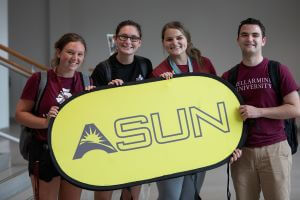 SportsCenter, meet Knights Nation.
SportsCenter, meet Knights Nation.
At a fan-filled news conference in the Centro Atrium on June 18, President Susan M. Donovan announced that Bellarmine University’s athletics program will move to NCAA Division I through an invitation from the ASUN Conference. The move, she said,
realizes one of the first initiatives in Bellarmine’s new strategic plan, to expand the university’s geographic reach to enhance its reputation and impact.
The Knights won’t compete at DI until the 2020-21 school year, but it was clear the plan was already working: Dozens of news outlets, including Sports Illustrated and USA Today, reported the move; the DI announcement ran all afternoon on the ESPN
ticker; and the entire press conference was broadcast live on ESPN+, with which ASUN has been a partner since 1989.
“The addition of Bellarmine University to the ASUN continues the rising trend of our league. We are extremely proud to become teammates with a great university and the Louisville-area community.” ASUN Commissioner Ted Gumbart
Board of Trustees Chair Bill Mudd called attention to the power of such exposure by referencing Bellarmine’s NCAA Division II men’s basketball national championship in 2011. Following that nationally televised game, searches and inquiries
from prospective students spiked. “With the move to Division I, we no longer have to wait for a national championship to play on the national stage,” he said.
Thanks to a significant number of DI schools in the region, moving to the ASUN also means that Bellarmine will be able to schedule more compelling non-conference games, perhaps even against universities such as Louisville, Kentucky, Western Kentucky or
Indiana.
Bellarmine will be the 10th member, and the fifth private university, in the ASUN Conference, whose members are spread across seven mostly southeastern states, from Florida to New Jersey—areas where the number of traditional college-age students
is growing.
“As a Division I school, we will be able to share all that Bellarmine has to offer with a larger audience than ever before, through increased media coverage and event attendance,” Dr. Donovan said. “This will allow us to recruit excellent
students from a much wider geographic area... and increase the diversity of our student body.”
Academics will remain Bellarmine’s top priority, she added. Division I maintains even more rigorous academic standards than Division II—standards that Bellarmine student-athletes already meet or exceed.

“Bellarmine is going to The Show,” said Athletic Director Scott Wiegandt, a two-time Bellarmine graduate, former professional pitcher and former BU baseball coach who has been AD since 2006. “In every way, this transition is the next
natural step. In 1985 I came here as a freshman. I experienced Bellarmine College at its fullest. I came back as a professional to coach at what transitioned into Bellarmine University. So this, it really seems like just the next part of the foundation
of Bellarmine’s future… But what is most exciting to me is that, like Bellarmine, the ASUN puts students first. That’s why I came to Bellarmine. I was a biology major. Sure, I came here to play baseball, but it was about getting
that degree, because I wanted to expand the field of play beyond my four years. Our student athletes are challenged academically, socially and athletically, and that’s how we are going to recruit. We’re going to do this with Bellarmine-profile
student athletes. This will be Bellarmine’s version of Division I.”
“I had an uncle who went here, and he can’t believe I’ll get to experience DI. My friends all said, ‘You’re officially DI—go tell everybody!’ Everybody thinks it’s really cool.” Lauren Deel, rising junior forward, women’s basketball
A possible move to Division I had been discussed for some time. Former President Joseph J. McGowan first looked into DI possibilities in 2001, and Bellarmine established its DI lacrosse program in 2005. This most recent exploration arose during the extensive,
12-month strategic planning process that President Donovan began in January 2018 and that involved significant input from faculty, staff, alumni, students and other community stakeholders. Expanding Bellarmine’s geographic reach and impact became
a consistent theme of these discussions.

Studies of conference realignment typically involve a great deal of confidential one-on-one negotiation. A school must accept a conference invitation that must then be approved by the NCAA. No conference wants to run the risk of inviting a school to join
only to be publicly rejected. Similarly, no institution wants to announce publicly its intent to make the transition to DI, only to find there is no invitation being offered. For those reasons, Bellarmine proceeded through the preliminary discussions
with utmost care. The ASUN vote to accept Bellarmine was unanimous.
Now the news is out, in a big way. And the whole city is celebrating.
Noting that Louisville had just celebrated Muhammad Ali Week, Mayor Greg Fischer declared at the news conference: “This is a very Ali-like move that Bellarmine is making here. Going big, saying we’re gonna be the biggest at what we want to
do and take on greater challenges.”
Then he took a peek into the future (following the four-year transition period the NCAA requires before NCAA Tournament play).
“Think about CBS Selection Sunday, to hear the name ‘Bellarmine Knights’ called. To see Scotty Davenport, calm and reserved and emotionless while that [announcement] is made, will be a wonderful thing to see ... This is just a beautiful
seed of success that is being planted for Bellarmine and our city today.”
Written by Carla Carlton
FREQUENTLY ASKED QUESTIONS
What is the timing to move to DI?
Bellarmine will compete in DII in the 2019-20 school year and make the move to compete at the DI level in the 2020-21 school year.
Can Bellarmine compete successfully at the DI level?
Bellarmine already competes effectively in men’s lacrosse and has for 15 years. Bellarmine has a long and distinguished history of success in men’s basketball competing at, or near, the top of DII for many years. In the 2018-19 season alone,
the Knights won national titles in track and field, dance and cheer. Men’s basketball and baseball also took conference titles, while men’s and women’s soccer and women’s basketball were conference tourney runners-up. Our coaches
have long recruited DI caliber student-athletes who chose to play in DII.
How did you choose which conference to join? Why ASUN?
First, it is important to note that a conference must invite a school to join, and if that invitation is accepted, then the formal application is made to the NCAA to move to DI. We wanted a conference partner that would help realize the priorities
of the strategic plan—including providing a transformative student experience, expanding our geographic reach and impact and demonstrating commitment to equity and inclusion.
ASUN offers the opportunity to expand our geographic reach into large metropolitan areas in eastern and southeastern cities beyond our traditional recruiting boundaries. In greatly increasing that recruiting footprint, there is greater opportunity
to become a more diverse and inclusive institution.
ASUN also offers us the important opportunity to compete in conference tournaments, such as the NIT, in the first year after the transition to DI. (The NCAA does, however, require a four-year transition period before a school can play in the NCAA
Tournament.)
Will all of Bellarmine’s sports have a home in the ASUN Conference?
Bellarmine fields 17 sports sponsored by the ASUN Conference.
Additionally:
- Men’s lacrosse, which has been a DI program since 2005, will continue as a member of the Southern Conference.
- Men’s and women’s swimming will participate in the Coastal Collegiate Sports Association.
- Field hockey and wrestling will compete in DI with independent status.
How long will it take to be competitive at the DI level?
Transitions are challenging, but that’s the nature of sport. Bellarmine believes in its student-athletes and coaches and we are confident we can establish ourselves quickly as a competitive program. The first two years in a new conference (2020-21
and 2021-22) are anticipated to be the most difficult due to the dynamics of recruitment and limits on post-season play. With each passing year of the reclassification process, these challenges will lessen.
Will Bellarmine be able to handle the increase in costs for DI athletics without affecting other parts of the university?
Yes, BU is committed to close monitoring of athletic expenses in order to continue to promote the academic core of the institution. The construction of a financial plan built around this goal has been an essential part of the exploration of a move
to DI. A new development plan is in process to fund the transition cost of specific facility upgrades and operational expenses over the next five years so as not to divert resources from academic programs. Additionally, fundraising for athletics
is done in conjunction with the university’s other fundraising efforts, in order to ensure we maximize opportunities and that one does not take away from the other. The administration and Board of Trustees are mindful of athletics expenditures
as a percentage of the university’s total budget. In planning for a DI transition, the percentage of the total spend will remain the same.
Will the move to DI require new athletic facilities?
While many aspects of our current facilities are DI-ready, some improvements will be necessary to keep them competitive and improve their revenue-generating potential regardless of competing in DI or DII. Examples are improvements to the baseball
and softball complex, to Knights Hall and to our Newburg Sports Complex. These improvements, which are in the design phase now, will improve game broadcasts, heighten fan experience and increase revenue generation.
What impact will this have on alumni?
The transition to DI will enrich the value of a Bellarmine degree for all graduates as BU Athletics increases media coverage and brand awareness for the university. Alumni fans will also benefit from the higher caliber of sporting events and spectator
experience resulting from Bellarmine hosting more DI teams on campus for games.
What impact will this have on the local community?
The increased awareness and expanded reach of Bellarmine can benefit the Louisville region significantly. Consider the financial impact of sustained enrollment growth: An increase of 100 students translates into a $3.8 million impact on the local economy.
In addition, the city will benefit from more visiting fans staying in area hotels and dining in area restaurants.
Will tuition increase?
Ensuring that a Bellarmine education remains affordable and attainable remains a top priority. Since the finance plan for a DI shift will cap the spending on athletics at the university’s current level, and any needed additional capital will
come from fundraising, there should be minimal impact on the university’s tuition structure.
Will Bellarmine add football?
“I get asked that all the time,” Dr. Donovan said at the news conference. Answer: No. Bellarmine currently meets NCAA rules requiring DI members to offer at least 14 sports (at least seven for men and seven for women, or six for men and
eight for women). Any potential additions will be assessed to ensure Bellarmine remains compliant with Title IX requirements, but football is not in the picture at this time.
EVERYTHING UNDER THE ASUN
The addition of Bellarmine in 2020-21 will bring ASUN membership to 10 institutions. Here’s a snapshot of the others.
Florida Gulf Coast University
Fort Myers, Fla.
“The Eagles”
Est. 1997
Undergraduates: 13,658
Jacksonville University*
Jacksonville, Fla.
“The Dolphins”
Est. 1934
Undergraduates: 2,841
Kennesaw State University
Atlanta, Ga.
“The Owls”
Est. 1964
Undergraduates: 32,274
Liberty University*
Lynchburg, Va.
“The Flames”
Est. 1971
Undergraduates: 47,050
Lipscomb University*
Nashville, Tenn.
“The Bisons”
Est. 1891
Undergraduates: 2,980
New Jersey Institute of Technology
Newark, N.J.
“The Highlanders”
Est. 1881
Undergraduates: 7,336
University of North Alabama
Florence, Ala.
“The Lions”
Est. 1830
Undergraduates: 5,846
University of North Florida
Jacksonville, Fla.
“The Ospreys”
Est. 1972
Undergraduates: 13,731
Stetson University*
DeLand, Fla.
“The Hatters”
Est. 1883
Undergraduates: 3,084
*indicates private university